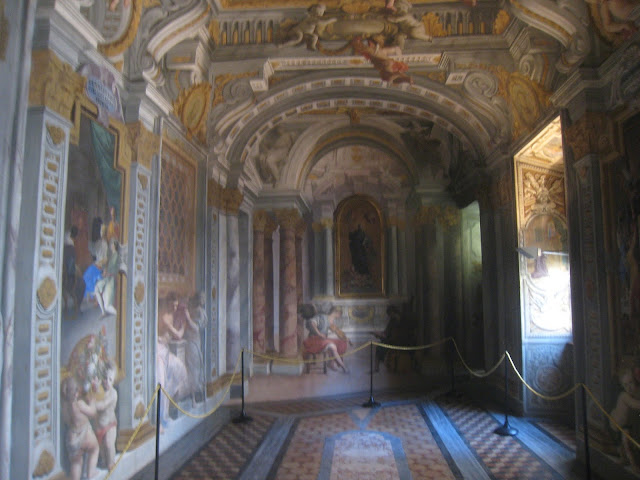 |
| A painting depicting an event in Saint Ignatius's life - in the corridor outside the Saint's rooms. |

The rooms of Saint Ignatius of Loyola (1491-1556), founder of the Jesuits, are smack dab in the middle of
Rome and only lightly visited. We've been there several times, and even we nonbelievers find them moving. Here is where he wrote the Constitution of the Jesuits. You can see the desk (which supposedly belonged previously to Saint Francis Xavier) on which he wrote, and his chair.
 |
One of the rooms where mass is held. In stark contrast to
Pozzo's decorated corridor. |
In fact, most of what one sees visiting these rooms was built after Saint Ignatius's death, but the core 4 rooms, constructed in 1543, where he lived and worked, and died, remain - or rather have been restored - as they were when he was there in the 16th century. As one passes through these simple rooms, one has the sense of walking back 5 centuries.
 |
A haunting likeness of the Saint. It was in one of the rooms decades
ago, and may still be there. But we can't remember seeing it.
Photo courtesy of Bo Lundin, author of an excellent guidebook to Rome--
in Swedish. |
The entrance to the rooms was decorated in high Baroque style about 25 years after Ignatius's death by Andrea Pozzo - an accomplished painter less famous than some of his contemporaries - who also had a hand in the designs of the Church of the Ges
ù next door. The Church gets most of the attention, and, so, being Rome the Second Time, we'll skip it for now and focus on Saint Ignatius's rooms.
 |
| Yes, that's trompe l'oeil perspective you are seeing here. |
 |
| Flat angels? |
Pozzo's elaborately painted reception area is worth a long look. His elaborate use of trompe l'oeil is delightful here (even if puzzling to some visitors who say his angels look flat!). You have to know where to stand (there's a designated spot on the floor; guards will point it out) to get the full effect of his faux-perspective. Although the ceiling paintings in the adjacent church of the Ges
ù are considered Pozzo's masterpiece, these corridor paintings are not to be missed. They are stunning in their color, Baroque busyness, and "quadratura," which I now know means a combination of architecture and fancy. It was by reading a
1991 New York Times article that we found Pozzo's frescoes had been whitewashed and only discovered with the late 20th-century restoration of the rooms. Of course, Pozzo's high Baroque style reflects as well the Counter-Reformation, in which Ignatius played a major role.

In contrast to this Baroque feast for the eyes, the austerity of Ignatius's rooms provides a quiet interlude for contemplation. On display are objects of the Saint's life, including his humble shoes (photo, left).
The Jesuits in charge of Ignatius's rooms have done a great service in providing many panels, in English, describing
Ignatius's life - he was a Basque military man who, like Saint Paul, had a conversion and became a man of the spirit, moving from a life as an elite to a monastic existence. The panels also describe the rooms and the objects in them. This is an excellent self-guided tour.
 |
Entrance to the rooms - to the right of the main entrance to
the Church of the Gesù. |
The church and rooms are halfway between Piazza Venezia and Largo di Torre Argentina, on the cramped Piazza del Ges
ù where the very busy via del Plebiscito changes names to the equally busy corso Vittorio Emanuele II
, easy to reach from any part of central Rome.
Hours for visiting the rooms are somewhat limited. 4-6 p.m. Monday through Saturday and 10 a.m. - noon Sundays and holidays.
There's very little online devoted to the rooms.
This Web site (in Italian, but one can use an online translator) is decent.
Dianne


No comments:
Post a Comment